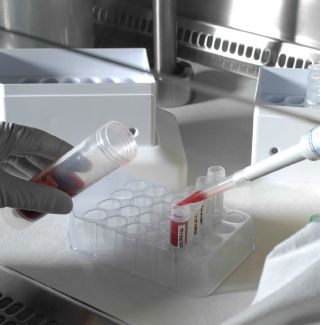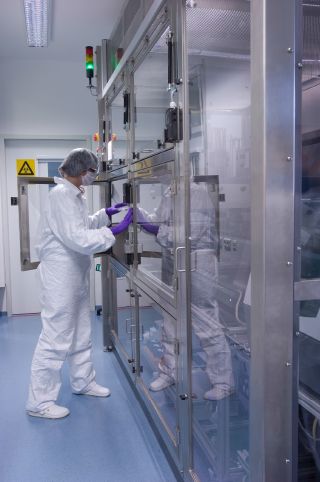iPSC Research and Applications
What are iPSC cells
Induced pluripotent stem cells (iPSC) are tissue or organ derived
cells that have been manipulated or reprogrammed to an embryonic
stem cell-like state by being forced to express genes and factors
important for maintaining the defining properties of embryonic stem
cells. A key feature and defining characteristic of pluripotent
stem cells is their ability to be propagated indefinitely whilst
maintaining stable properties in tissue culture. As an established
iPSC line, each reagent becomes a powerful tool to study biology of
normal development and disease specific processes in the
laboratory.
Mouse iPSCs were first reported in 2006, and human iPSCs in late
2007. Human iPSCs demonstrate important characteristics of
pluripotent stem cells, including expressing stem cell markers,
forming cells of the three principal (primary) tissue layers in
organisms (ectoderm, mesoderm & endoderm) and are capable of
generating cells of the three primary tissue layers. The discovery
of how to induce the pluripotent state via "de-differentiation" in
cells whose developmental fates had been previously assumed to be
determined, has opened up several new avenues of applied research.
Crucially the method has now made research into how the behaviour
of our various cells and tissues are affected by our genes, much
more possible and medical research into the causation and eventual
treatment of disease can now be performed with greater accuracy.
EBiSC providing access to a large repertoire of genetically diverse
cell lines will enable more accurate predictions of patient
responses to drugs in clinical development. In the future, human
iPSC lines may commonly be used in transplantation medicine, either
as the source of the therapy itself or as the basis of a test for
predicting safety of novel cell based medicines. Understanding how
to induce pluripotent stem cells will also help researchers develop
strategies to reprogram cells and repair damaged tissues, in
situ in the human body.
In addition, gene editing technology is a critical tool for iPSC
research and target validation. Using custom-designed and
sequence-specific double DNA strand cutting enzymes, like the
CRISPR/CAS9 system or TALENs, gene engineering in human cells has
become an elegant tool to generate new disease models.
Further reading
For more information about stem cells (how they can be made, what
they can be used for and any hazards to be aware of etc.), the
following sources of information can be consulted:

Aliquotting a sample under the clean
bench © Fraunhofer IBMT, Photo: Bernd Müller
Applications of iPSC for Drug Development
Consistent supply of standardized, high quality iPSC lines from
the EBiSC facility is envisioned to greatly facilitate many
categories of research in this important area of stem cell science.
These span from the intricacies of the mechanism of reprogramming
to factors determining pluripotency and how individual cell fates
are programmed in stem cells. Biotech companies and SME research
into the development of new cell processing procedures which are
more reliable, affordable and efficient, will also be assisted via
access to EBiSC’s iPSC lines.
The areas that are most likely to benefit however relate to
industry-based research to understand the genetic basis of disease,
how individual patients within a given diagnosis are different, the
development of new medicines as future treatments and in support of
clinical research to understand individual patient responses to
medicines being tested.
Typically, medicines fail during clinical development due to lack
of efficacy, even when they have been demonstrated 'a priori' to be
safe. This is most likely due to a lack of use of disease relevant
human cells early in pre-clinical phases of development. The EBiSC
bank provides a human iPSC repository to address this and thereby
make future drug development more effective.
Major applications of iPSCs include:
- Disease modelling and phenotypic screens: disease
representative iPSC cell lines can be differentiated into specific
cell types to create “disease-in-a-dish” cell models to screen
drug compounds for desirable phenotypic effects on the cells.
- Target validation: Cells differentiated from iPSC lines provide
the means for a cell-based assay, which can be used to validate
disease modifying processes in a more physiological relevant
context, instead of studying the action of the drug compound on
the purified target in isolation.
- Mechanism of action (MoA) studies: Phenotypic and target
validation screens contribute greatly to the pre-clinical
determination of the mechanism of action of a future drug. A
clearer understanding about how the drug compound works in the
pre-clinical stage leads to a higher probability of drugs
succeeding later in clinical development.
- Precision Medicine: By far the most exciting prospect to emerge
from the industrial use of disease relevant iPSC lines, is a
realization that the technology can assist drug developers by
identifying individual patient's disease at the molecular level
and then to utilize targeted treatments (possibly in combination)
to address that individual patient's disease process.
- Pharmacoviligence: iPSC technology may play an important role
in post-marketing surveillance of approved drugs, by providing a
cell-based assay to identify the molecular correlation of
individual patient-drug response variations. Using these assays,
the drug safety monitoring process can be carried out at
unprecedented resolution.

Automated cell culture © Fraunhofer
IBMT, Photo: Bernd Müller